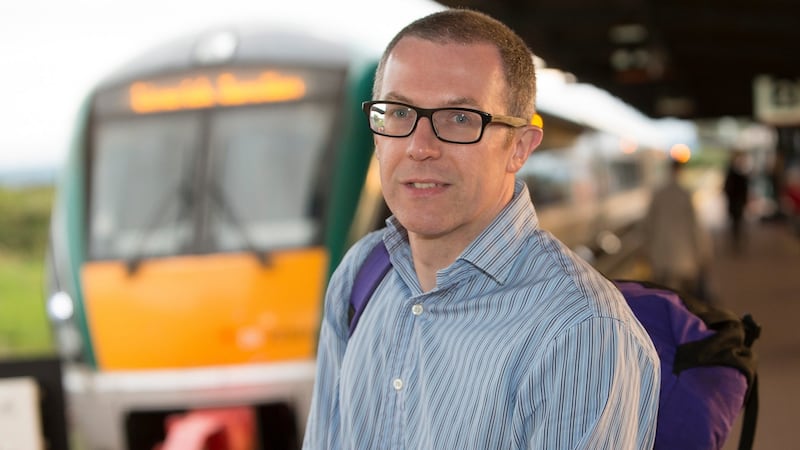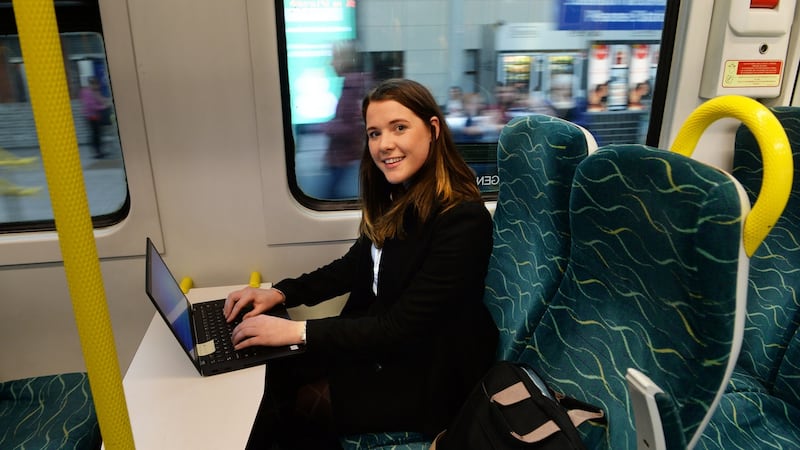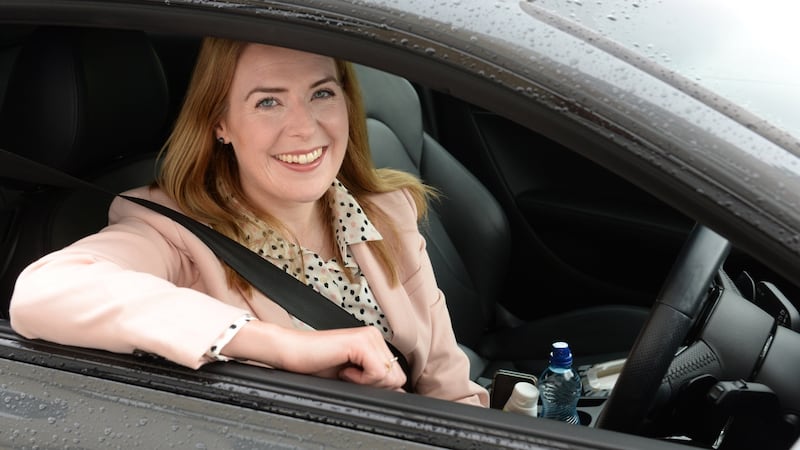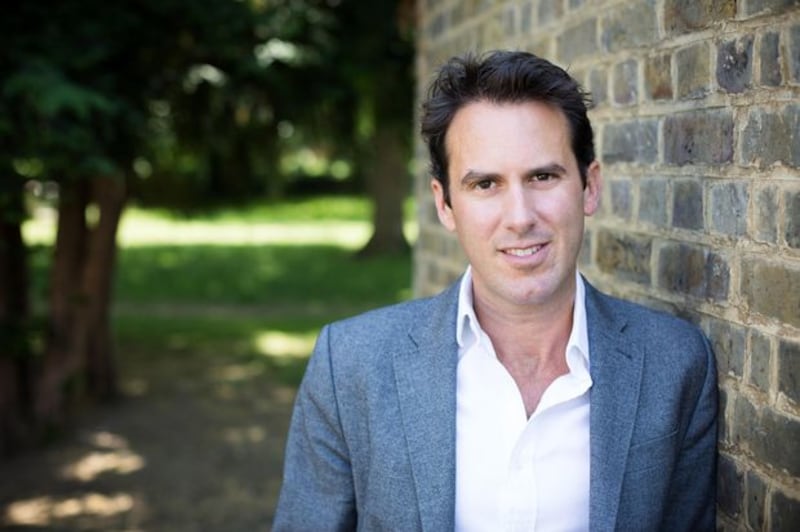It is 5.45am on Tuesday and still dark out. There are just four people sitting in the waiting area of Colbert Station in Limerick ahead of the departure of the first trains to Galway and Dublin. At 6am a member of staff lifts the shutter on the coffee counter as more people shuffle into the station.
Maurice Foley, a management consultant, arrives minutes later for his daily commute to Dublin. He makes a beeline for the front carriage of the train to Limerick Junction, knowing from 15 years of travelling this route that it will leave him in the right spot to board the last carriage, the quiet carriage, of the connecting 5.50am Cork-Dublin train and will still be covered by the platform’s rain shelter.
“It is one of the bleakest spots on the Earth, particular in the winter,” says Foley (37), pointing out that the rain often blows in horizontally at that time of year.
Boarding the nonstop train to Dublin at 6.45am, the Limerick man knows his commute down to each minute. He wakes up at 5.30am, leaves his house in Limerick at 6am and makes it to the station at 6.07am or 6.08am in time for the 6.15am train to Limerick Junction. There, he has the benefit of being a member of a group of commuters whose daily routines for years have made them friends.
“I got married in 2014 and 10 of my commuting friends and their wives came to the wedding. That might give you a sense of how close a group we are,” he says.
This group is part of Ireland’s commuting class, a large and growing section of the population that, for many of them, have had to – or chosen to – commute long distances. For some, they are commuting to avoid the pressures of increasing mortgages and rents and the general higher cost of living in or near Dublin. For others, it was because there were better career prospects or they were in a specialised line of work that forced them to travel, or simply because they did not want to uproot their families.
Public transport and population migration figures show that more of the country is on the move as the economy surges back from financial crisis and recession. The cost amounts to several thousand euro a year in tickets or petrol but, more significantly, sacrificing valuable time with family and friends.
It is trade-offs," explains Foley, the father of a 10-month-old child. "I have a Dublin salary with a Limerick mortgage
For the Limerick commuter group, career, family and quality of life explain why they live about 200km from where they work and why they spend more than five hours a day travelling.
“It is trade-offs,” explains Foley, the father of a 10-month-old child. “I have a Dublin salary with a Limerick mortgage so we are able to afford just me working and my wife as a stay-at-home mom. I am not sure that that would be possible if I lived in Dublin.”
The annual rail ticket costs €5,000, which can be offset against tax. The ticket costs €1,800 in 2005, he says, and the group has not seen a commensurate increase in the quality of the service since then.

At Limerick Junction, Foley meets John Maguire, who works in the academic sector, and several other members of their group on the long platform. Maguire has been travelling this route for nine years.
Physical separation
Describing himself as “a bit of a home bird”, Maguire says his wife initially found a job in their home town in Limerick and he a job in Dublin. Newly married, he tried for a time living part of the week in Dublin and driving up and down on Fridays but it took a toll on him. Now he has two children and physical separation between his family life in Limerick and work life in Dublin.
People look at me as if I am mad but I want to live in Limerick.
“People look at me as if I am mad but I want to live in Limerick. I lived in Dublin for three or four years. I had a great time. I loved the city, it is a great place to live. But we both kind of felt that we didn’t want to raise a family there. We just wanted to be home with the kids,” he says.
At the junction, one member of their group who boarded earlier, at Mallow in Co Cork, has saved them all seats. Five of them sitting together have, combined, 50 years of taking the train to Dublin. In that half-century worth of travel, they have witnessed it all: a couple having sex in a toilet, train staff being abused, thefts from the food and drinks trolley, confrontations with other passengers.
“She was a psycho,” says software engineer Derek Noonan (42) of a passenger he accidentally spilt a cup of tea over. “‘You ruined my pants!’ she screamed.” An offer to pay for dry cleaning failed to stop her mouthing off for the rest of the journey.
“There was more of them than there was of us,” says Foley of another run-in the group had. “They were a big and large family – let’s just leave it at that,” says Kieran Brennan (46), a software developer.
Do you commute long distances? Share your story by sending an email to to commuters@irishtimes.com with your name, a contact number and a short description of your commute
Jim Lovett (51), who runs a facilities company, has been taking the train from Co Cork for 17 years. He used to take the 5am “mail train” that stopped at every station to be in Dublin for 9am meetings. He remembers the days of the dining car and being able to order a “proper breakfast”.
“They used to have a chef, frying things,” says Brennan.
’Cowgate’
There was that time the train hit a cow – “Cowgate”, they call it – and it took eight hours for a journey that should be just over two hours. There was “The Big Freeze” several years ago when the water in the toilets froze and signals failed. It led to a long delay and even forced passengers to urinate out a train door.
Foley recalls at least three or four trains being delayed by suicides on the tracks.
I have seen couples break up on the train. I have seen couples find out they have been cheating on each other… When people are on the phone, they think they are in their own vacuum of silence,"
Close proximity with passengers leads to colourful eavesdropping. The group is good at spotting those recently released from prison or heading up to Dublin for a court appearance. They have overheard sensitive conversations and seen confidential corporate reports laid out on communal tables.
“I have seen couples break up on the train. I have seen couples find out they have been cheating on each other… When people are on the phone, they think they are in their own vacuum of silence,” says Foley, adding that on his own business calls he tends to speak in code.
“It’s hardly the world’s most unbreakable code,” says Noonan, ribbing his friend.
There is plenty of banter in the group. One of their long-running “threads” is based around how useless their careers would be in a post-apocalyptic world and what new roles they would take on, discussing significant tasks such as “who is charge of procreation?” and “how do we get the human race back up and running again?” It all helps keep their spirits up.
The five men, all married, attest to the importance of having a strong support structure at home, be it a very understanding wife, relatives or friends. Lovett recalls his wife falling very ill one time during his commute and he had to continue on his nonstop journey to Dublin in order to travel back to Cork.
“When the kids were sick when you were younger, you’d get that call,” says Brennan. “If there is an emergency at home, you could be three hours away. There is absolutely nothing you can do.”
There are a lot of downsides to it," says Maguire. "Oonagh [his wife] is like a single parent from Monday to Friday.
He recalls having to give up coaching one of his children’s teams as they got older because they added midweek training. “That was a huge thing,” he says. “You just have to accept it.”
“There are a lot of downsides to it,” says Maguire. “Oonagh [his wife] is like a single parent from Monday to Friday. Most times I come home and my children are in bed. Most of the responsibility for all the family stuff falls on Oonagh’s shoulder because she is around.”
Recovering
Commuting requires constant management and devoting weekends exclusively, or at least as much as possible, to family time, switching off laptops and mobile phones, and recovering from the week’s travel.
“Oonagh checks in with me periodically, asking me, ‘are you happy to keep doing it?” says Maguire. “I say, ‘Limerick is my home and this is where we live. The kids have a life here.’”
Others ask themselves similar questions at regular intervals.
“Twice a year I question my sanity,” says Foley. “I just go, ‘what am I doing?’ It lasts about half an hour and then I get back on the train. You do have to watch it. I am sure that it does take a toll but I don’t know anybody who has an ideal situation.”
There are more jobs than places to live, says Foley of the chronic housing shortage in Dublin.
The group has seen a noticeable increase in the number of regular people commuting. The economic recovery has concentrated the number of new jobs in and around Dublin. New technology, be it new-generation mobile phones, remote access to work computers or video conference calls, along with flexible working hours, means that employees no longer have to be chained to desks nine to five.
“There are more jobs than places to live,” says Foley of the chronic housing shortage in Dublin.
The Government's failure to encourage greater economic activity outside Dublin is a source of anger for the travelling group. Talk of the potential for Limerick being the country's "second city" with the port at Foynes, Shannon Airport nearby and a tunnel under the river Shannon excites these commuters but they point out the absence of a motorway joining Limerick and Cork as a major gap in the network.
“We have the backbone of an infrastructure if they just joined it up,” says Foley, as the train speeds past green fields in the midlands.
“It is scandalous,” says Noonan of the misguided Government policy. “Dublin is a pressure cooker. It is going nuts again. Look at property, look at rent.”
“We have to break this inevitable crawl to Dublin,” says Brennan.
Rental crisis
In a week when a report from property website Daft showed rents at an all-time high and housing supply at an all-time low, the prospect of Ireland’s commuter class growing even more rapidly is very real. The numbers travelling to and from work has risen sharply with the economic recovery.
Census 2016 showed that more people were commuting to work, taking longer to reach their workplaces and leaving home earlier in the morning than in 2011, the peak of the economic crisis. In 2016 there were 1.88 million people commuting to work, an increase of 10.7 per cent on 2011. The average time taken to reach work was 28.2 minutes in 2016, up from 26.6 minutes, while 81 per cent of journey times were under 60 minutes. Some 365,369 workers left home before 7am, an increase from 272,864 in 2011.
The biggest population increases were in towns and villages across the Dublin commuter belt. Saggart in south Dublin was the fastest-growing town, rising by almost 46 per cent since 2011. Among the larger towns of more than 10,000 people, Maynooth grew the fastest, increasing 16.6 per cent since 2011, followed by Ashbourne (11.7 per cent), Portlaoise (9.5 per cent) and Balbriggan (8.8 per cent).
The 2011 census showed that almost one in 10 workers spent one hour or more commuting to work. The CSO is due to publish more Census 2016 statistics on commuting at the end of this month, but town-by-town statistics released last month show big increases in the number of people taking an hour or more to commute to work, school or college from Dublin’s commuter-belt towns in the past five years.
The number was up 46 per cent for people living in Maynooth, 44 per cent for Wicklow, 35 per cent for Naas, 34 per cent for Ashbourne, 33 per cent for Newbridge and 32 per cent for Kildare. The numbers in Limerick taking an hour or more to reach their work, school or college was 23 per cent higher. The overall percentage increase in the number of people commuting to work, school or college over the five years was the mid- to high-teens in many commuter-belt towns, while the number of people having to leave earlier in the morning – between 8.01am and 8.30am – had also significantly increased.
There is "concentrated employment" but "deconcentrated residences" and that is not good for people's quality of life
Ronan Lyons, an economist at Trinity College Dublin and author of the Daft report, says that, despite the recent construction boom, there are still too few apartments in Dublin for its growing population, making Ireland into more a "sprawl country". There is "concentrated employment" but "deconcentrated residences" and that is not good for people's quality of life, he says. He envisions an increase in both commuting and cramming in existing housing.
“There is so little availability out there that you have to come up with something to make it work and if it is effectively trading petrol and time for rent then that is the choice that people are left with. It reduces their costs in terms of housing and childcare but it cuts at their quality of life,” he says.
Childcare costs
This is certainly the case for Christine Mooney and her husband, Jasper Kwak. Childcare costs drove them out of Dublin in 2009 after they had their first child.
Now they live in Clara, Co Offaly, and try to make the most of the many hours they spend commuting to their jobs in Dublin in their 2010 Renault Megane. Jasper (40) likes to listen to new albums; Christine enjoys the radio and audio books. She tends to sleep on the way home. Christine (39) works week on, week off. When she works, she drops her husband at Celbridge where he is picked up by a colleague heading to their office in Citywest. She then travels on to her job in Dún Laoghaire.
They have been commuting this route for more than seven years. Their car has more than 400,000km on the clock from the 260-km return trip to her job in Dún Laoghaire. When they both work, they drop their three children – aged one, six and eight – with her mother near her home in Moate, Co Westmeath, at 6.40am and sometimes do not pick them up until 7.30pm. The nature of their commute means that she could not work full-time, she says.
"We don't really have another option," says Jasper. "There's no State-provided creche or any kind of support where you can bring your kids
“We don’t really have another option,” says Jasper. “There’s no State-provided creche or any kind of support where you can bring your kids so the only option we had is doing it this way. I haven’t really thought too much about the alternative because there isn’t one. I don’t want to beat myself up.”
No other option
He believes the Government offers little support to people forced into long-distance commutes. Fuel is taxed very heavily and tolls make travelling by road unattractive, but with no proper public transport option and no affordable childcare the couple do not have any other choice.
Christine says she can spend up to five hours a day in the car on the days she is working. Even rain on the M50 ring-road around Dublin can add an extra half-hour to an hour on to her journey.
For her, however, the quality of rural life in Co Offaly for her children, a home on lots of land, small class sizes, cheaper rent, being close to family and her love for her job make the commute worthwhile.
“We will be doing the commute as long as we have the health to do it,” she says.
It is really, really stressful. It is like doing a job and a half. You work for seven and eight hours and you drive for four hours,"
Victor Ogunpola (46), who moved here from Nigeria 14 years ago, leaves his home in Longford town at 5.30am and reaches his workplace in Citywest between 6.50am and 7am giving him up to an hour of free time before he starts work.

He likes to beat the heavy traffic and the stress that comes with driving through it. He is usually home by 8pm. The commute would take him even longer by public transport.
“It is really, really stressful. It is like doing a job and a half. You work for seven and eight hours and you drive for four hours,” says the father of three.
Traffic volumes
Traffic figures provided by the Transport Infrastructure Ireland (TII) show that the main routes into Dublin – some of the country’s busiest roads – are at, or close to reaching, choking point.
A 2014 study estimated that demand on the M50 between the junctions with the Galway and Limerick/Cork roads would rise to 143,000 vehicles by 2023. The average daily traffic has already reached 141,324 this year, an increase of 27 per cent since 2013. The number of unique daily journeys where a driver travels between two interchanges has reached 400,000, indicating that the M50 is being used even more for short journeys.
Traffic volumes have also risen by 27 per cent on M7 to Limerick/Cork over the past four years, while there have been increases of 16 to 20 per cent on the M1 to Belfast and the M3 towards Cavan, explaining the heavy flows on to the M50. The five-car crash that backed up the M50 on Tuesday morning's commute – outside school time, when traffic volumes are traditionally much lower – showed shows the extent of the problem.
Mara Burke (36) travels the M7 motorway to Citywest outside Dublin from her home in Stradbally near Portlaoise. On a good day she will leave home at 6.20am and it will take her an hour and 10 minutes.
On a bad day, particularly on Monday mornings and Friday evenings, the journey takes another 20 minutes. She spends the time in her car listening to YouTube tutorials to prepare for her accountancy exams.
“The Government should encourage companies with incentives to leave Dublin and come to other areas of the country because everything is concentrated in Dublin. More people are commuting because there are no jobs in Portlaoise,” the Brazilian-born woman says.
The increases in traffic are not unique to the arteries around Dublin. Sinead King (33), a teacher, has noticed "way more cars" on the road on her commute from Carna in south Connemara to Galway – a commute she has done for the last six years in an effort to save money to buy a house in the city by living rent-free at home. She used to leave at 6.45-6.55am; now she departs at 6.30-6.35am due to the traffic.
She travels the coast road via Spiddal even though the traffic on it is a lot heavier because she wants to avoid the main road between Galway and Clifden. That N59 route is "so poor" and "holds an awful lot of water in the wet weather", she says. Signs erected by locals berate the Government over the state of the N59. "An insult to the people of Connemara," says one. She has travelled the coastal route so much she knows whether she is late or not if she is in front of or behind a particular bus.
King, as like other commuters, finds the first weeks back commuting after the summer the most tiring. “You just become accustomed to it. You have that peace and that headspace. You go on autopilot once you get into the car and you know the journey that is ahead of you,” she says.
Commuter traffic
Public transport into Dublin has also seen an uptick in commuter traffic. The number of people passing over the 33 bridges across the Royal and Grand canals into the city – the so-called “canal cordon” – between 7am and 10am every morning rose to 202,000 in 2016, an increase of 10 per cent from five years earlier.
Over that time, there was a 13 per cent increase in the numbers taking public transport with 98,273, or 48 per cent, of all commuters into the city choosing to travel into city that way. Car journeys were down 7 per cent while cyclists and walkers were up 76 per cent and 47 per cent respectively.
Iarnród Éireann says passenger numbers on the Dublin-Drogheda line, the busiest commuter line into the city, are up 15.3 per cent since 2014.
More than five million passengers travel on that line every year. Passenger numbers on the Dublin-Wicklow train have increased 11.3 per cent in the past three years, Dublin-Kildare by 18.3 per cent and Dublin-Maynooth by 27 per cent. The Dart, the country’s busiest rail route overall carrying 19 million passengers last year, has seen traveller numbers increase by 27.7 per cent in the past three years.

“The trains are very busy so you would be lucky to get a bit of work done when you have got a signal,” says Courtney Cullen, a tax manager who commutes from Wicklow town to her office in Dublin city centre on the train.
She leaves home at 6.20am every day to make it to her desk at 8am. She refuses to get up out of bed before 6am and considers 16 hours-a-week commute “dead time”.
I have breakfast and do my make-up on the train. That is 20 minutes of your journey. I make sure I have my breakfast packed the night before. You have to be quite organised."
“I can’t bear to see ‘5’ written on my alarm clock. It makes you feel a bit sorry for yourself,” she says, laughing. “I have breakfast and do my make-up on the train. That is 20 minutes of your journey. I make sure I have my breakfast packed the night before. You have to be quite organised.”
Flexi-time allows her to leave her desk at 4.30pm to be back home for 6pm.
Cullen (27) has chosen to work in Dublin because of the career opportunities but to live in Wicklow because she loves her home town and loves “being out in the fresh air and not knocking shoulders as you are trying to walk down the street”. She adds: “You work to live – you don’t live to work.”
Ian Cahill (44), who works in Dublin, likes living in Mullingar despite the 80-minute commute on the train each way. Being in the IT business means there are better job opportunities in Dublin but he likes the “greenery” and the lifestyle in and around Mullingar. Juggling his duties as a father of three is “tricky”, he admits, when he is away for long periods but it helps that his wife is a stay-at-home mum.
There is no question about it: you do miss out at that time during the week. When you are getting back at 7pm there is a limited amount of time that you are going to spend with them."
Limited time
“You would like to spend more time with the kids,” he said. “You end up doing it at the weekends. There is no question about it: you do miss out at that time during the week. When you are getting back at 7pm there is a limited amount of time that you are going to spend with them.”

Caroline Rocks (33), an engineer with a pharmaceutical company and a part-time lecturer, commutes from Blackrock in Co Louth to Dublin every day. and once a month travels to India for a week's work, helping her multinational employer scout for new manufacturing locations. She flies business class through the Middle East and enjoys the travel, having missed out on a gap year abroad in her 20s.
Door-to-door, her Irish commute is an hour; her commute to India takes between 15 and 16 hours. The two commutes have pros and cons, she says. “I like the mix at the moment, that I don’t have a constant drive every single day, that I have a bit of a break and am able to go abroad.”
Rocks has noticed the increase in traffic in the M1 from Dundalk – it amounts to 16 per cent over the past four years, according to TII figures – but does not see the route as congested as the M50.
“This is the last week of school holidays, so from next week it will be busier and I’ll have to set my alarm clock about 15 minutes earlier,” she says.
International commuting out of Ireland became more commonplace when the recession hit.
David Ralph, an academic at Trinity College Dublin, says some commuters viewed him more as a relationship counsellor than as a sociologist when he was researching his 2015 book, Work, Family and Commuting in Europe: The Lives of Euro-commuters. Many of the 37 commuters he interviewed for the study spoke about the complications of juggling family and working life, and expressed anger at the mismanagement of the economy by the Government that led to the recession and forced many to commute overseas for work.
Everyone framed it as a temporary thing, something they would do for two, three or five years and a lot of them were taking active steps to upskill and to get out of it effectively"
They talked to him anonymously about the toll it took them: the fatigue, the loneliness of being away from family during the week, and the intense family time and high expectations at weekends that meant sacrificing personal time with friends and involvement in their communities.
“Everyone framed it as a temporary thing, something they would do for two, three or five years and a lot of them were taking active steps to upskill and to get out of it effectively,” he says.
Uneven economic recovery
Ralph believes the uneven economic recovery has meant people haven’t stopped commuting out of Ireland but they have become more established commuters. He expects an increase in Europe-wide commuting with multinationals relocating from London to other capitals, including Dublin, post-Brexit.
“If they have families, they are not going to uproot them – they are going to commute. Dublin will become a commuting destination rather than a place people commute from,” he says.
Career is the driver for many of Ireland's international commuters who spoke to The Irish Times.

Chris O’Donoghue packed up his family and moved them back to Cork almost a year ago after 10 years in London. The cost of educating his two daughters in Fulham was too much and the schools in Cork, where his wife is from, were just as good. He flies to London on the 7.20am flight every Monday for the working week running his own sports marketing agency, returning on a 6pm flight on Fridays. Door-to-door, it takes him about 2½ hours. During the week he lives with his sister in London.
“I would love to do what I would do in Ireland sooner rather than later but there isn’t a huge market for it yet so I am kind of stuck between a rock and a hard place financially,” says O’Donoghue (39).
“The main upside for me commuting is working in one of the greatest cities in the world and being able to stay in the countryside and in a fantastic Irish city that is thriving more than ever before. You can have the best of both worlds.”
Short but gruelling
Tulsen Tollett has a shorter but more gruelling commute travelling from his home in Oughterard in Connemara, Co Galway, to his job as a sports presenter on BBC World News in Manchester.

The Australian, a former professional rugby league player, leaves home at 12.45am on a Sunday to drive to Galway and catch a 2.15am bus to Dublin Airport and a 6.30am flight onwards to Manchester. Most of the time he starts his shifts at the broadcaster at 6pm that evening. He travels back to Galway at the end of a 3am shift on either a Wednesday, Thursday or Friday.
Tollett (44) says his “outstanding” wife, who juggles 25 hours of her own work a week and three young children, allows him to devote so much time away from his family to do his job.
I like doing it [the commute] because I love my job. If it is a job that you enjoy, it is not really a job. That's my motto."
“I split my life in two: there’s a life of me here working and there’s a life of me when I go home. When I get home, I leave my phone alone,” he says.
“I like doing it [the commute] because I love my job. If it is a job that you enjoy, it is not really a job. That’s my motto.”

Steven Rice, who is originally from Newcastle in Co Down, says he has been living on planes for many years. He runs a marketing company in Ras Al-Khaimah, the northern-most emirate of the United Arab Emirates, and returns to Ireland once every three to four weeks for two weeks at a time.
His wife and two sons live in Donabate, Co Dublin, and he is sacrificing family time now to grow his business to a certain point so that he will have more freedom to be around his sons in a few years when they are teenagers. Rice (46) says there are good opportunities in the Middle East for a brand and digital marketing business like his and it would be hard to set up a similar company in Ireland.
“I can only do this for so long,” he says. “My family is too important for me for this to be a long-term arrangement. The whole idea is to be able to spend more time with my teenage boys. The father-figure is important then. It is just something we – me and my family – decided to take a risk on. It is a bit of a gamble but so far it looks like we are winning the gamble.”
We would like to hear from commuters. What is your experience?




















